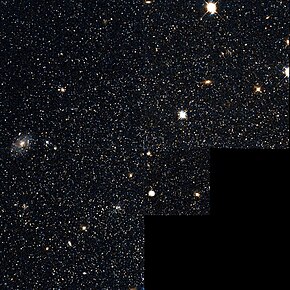Andromeda I is a dwarf spheroidal galaxy (dSph)[5] about 2.40[4] million light-years away in the constellation Andromeda. Andromeda I is part of the local group of galaxies and a satellite galaxy of the Andromeda Galaxy (M31). It is roughly 3.5 degrees south and slightly east of M31.[6] As of 2005, it is the closest known dSph companion to M31[7] at an estimated projected distance of ~40[4] kpc or ~150,000[6] light-years.
| Andromeda I | |
|---|---|
 Andromeda I by the HST | |
| Observation data (J2000 epoch) | |
| Constellation | Andromeda |
| Right ascension | 00h 45m 39.8s[1] |
| Declination | +38° 02′ 28″[1] |
| Redshift | -368 ± 11 km/s[1] |
| Distance | 2.40 ± 0.08 Mly (735 ± 23 kpc)[2][3][4] |
| Apparent magnitude (V) | 13.6[1] |
| Characteristics | |
| Type | dSph |
| Apparent size (V) | 2.5′ × 2.5′[1] |
| Notable features | satellite galaxy of M31 |
| Other designations | |
| And I,[2] Anon 0043+37,[1] PGC 2666[1] | |
Andromeda I was discovered by Sidney van den Bergh[8] in 1970 with the Mount Palomar Observatory 48-inch telescope.[5] Further study of Andromeda I was done by the WFPC2 camera of the Hubble Space Telescope. This found that the horizontal branch stars, like other dwarf spheroidal galaxies were predominantly red.[9] From this, and the abundance of blue horizontal branch stars, along with 99 RR Lyrae stars detected in 2005,[7] lead to the conclusion there was an extended epoch of star formation. The estimated age is approximately 10 Gyr. The Hubble telescope also found a globular cluster in Andromeda I, being the least luminous galaxy where such a cluster was found.[10]
See also
References
External links

- Andromeda I on WikiSky: DSS2, SDSS, GALEX, IRAS, Hydrogen α, X-Ray, Astrophoto, Sky Map, Articles and images